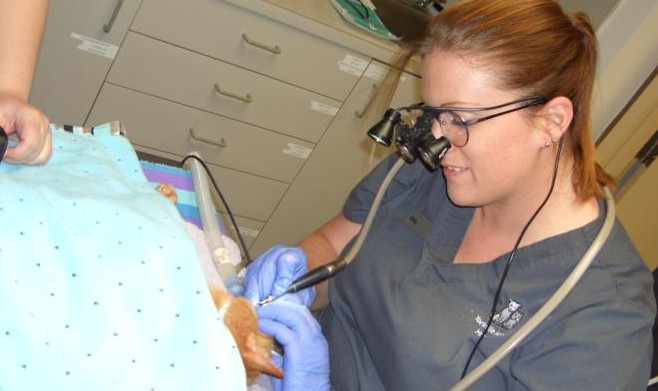
Regular professional dental cleanings and good dental home care are essential if we want to keep our pet’s mouths healthy and pain-free. You may have heard several other names for this procedure, including a “dentistry”, a “dental”, or a “dental prophy”. None of these terms adequately describes the procedure that they refer to, and veterinary dentists are still arguing as to what this procedure should “officially” be called.
care are essential if we want to keep our pet’s mouths healthy and pain-free. You may have heard several other names for this procedure, including a “dentistry”, a “dental”, or a “dental prophy”. None of these terms adequately describes the procedure that they refer to, and veterinary dentists are still arguing as to what this procedure should “officially” be called.
Traditionally, veterinarians have done a poor job at educating pet owners on the importance of regular dental cleanings. Too often, we wait until there is significant gum disease before recommending intervention. This is too late, and permanent damage has likely already occurred. That is a shame, because most dental disease is very preventable, with proper regular care and treatment.
Plaque is a slimy substance composed of bacteria, saliva, and mucoid substances that adhere to teeth. It is the plaque which collects just underneath the gumline that eventually causes inflammation, gingivitis and periodontal disease. This plaque can be removed by routine dental homecare such as brushing.
Within three to five days, minerals are deposited into this plaque, forming a hard deposit on the teeth called tartar. Once tartar has formed, brushing will no longer get rid of it — only a dental scaling will remove this substance once it has mineralized. The tartar is an excellent place for more plaque and bacteria to attach, causing a gradual worsening and deterioration of your pet’s dental health.
A complete dental cleaning procedure is designed to remove this plaque and tartar from the teeth, and to help prevent it from coming back as quickly. It also involves a complete and thorough examination of each and every tooth, both above and below the gumline, with the aid of dental radiographs. If any additional problems are found, further treatment may be necessary.
Have a look at all the steps we go through during one of these procedures…
Complete oral examinationOnce the patient has been anaesthetized, we do a detailed examination of each tooth, looking for damaged or missing teeth, tooth mobility, malocclusions (teeth not fitting together properly), and presence of gingivitis and periodontal disease. A special instrument is used to probe around each tooth to see if any deep pockets exist around the roots of the teeth, which would require special care.
|
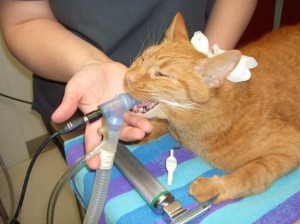 |
Dental radiographsDental radiographs are performed, usually of the entire mouth, to look for evidence of any disease below the gumline or within the teeth. For a more detailed description, please see our dental radiography page.
|
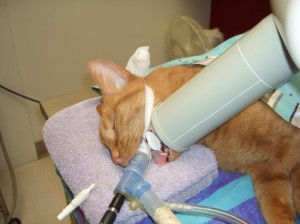 |
Supragingival tartar and plaque removalSupragingival (above the gumline) tartar and plaque are removed with hand instruments called scalers as well as ultrasonic scalers. Water is continuously sprayed onto the teeth during ultrasonic cleaning to cool the surface of the tooth and prevent heat damage to its internal structures.
|
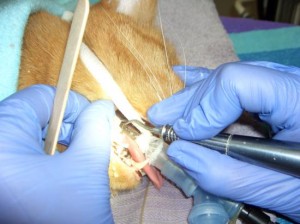 |
Subgingival scaling and root planingSubgingival (below the gumline) cleaning is the most important part of the dental cleaning procedure. It is the tartar and plaque that accumulate here that cause gingivitis and eventually lead to periodontal disease. If more advanced infection has set up around the root of the teeth causing bone loss, then root planing involves scraping the tartar and debris from around the roots that are no longer attached to bone.
|
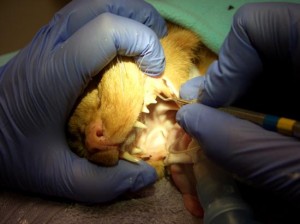 |
PolishingWhen teeth are scaled to remove plaque and tartar, tiny little grooves and irregularities are left behind in the enamel of the teeth. These grooves are excellent places for bacteria and plaque to attach and start the process all over again. Polishing the teeth with a coarse powder after scaling eliminates these tiny grooves, leaving a smooth enamel surface that plaque has a much harder time “grabbing onto”.
|
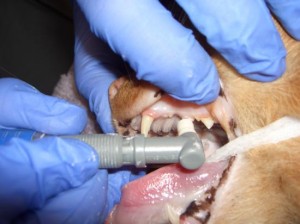 |
IrrigationThe sulcus is the small space just under the gumline around the tooth where plaque and bacteria can do their most damage. After scaling and polishing, the sulcus is irrigated, or washed with water to remove any remaining plaque and debris that has been left.
|
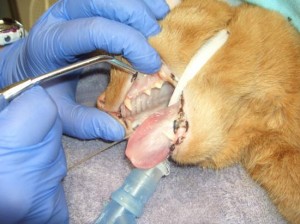 |
ChartingOnce the cleaning has taken place, all problems or abnormalities encountered are charted or recorded for future reference. Any missing teeth, extractions, periodontal disease, masses, broken teeth, or treatments performed are recorded in detail, so that we may assess any progression of problems from one year to the next.
|
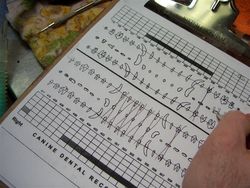 |
Additional proceduresIf abnormalities have been found during your pet’s procedure, such as significant periodontal disease, cavities, fractures, or any other lesions, then other specific treatments may need to be performed. Once again, it is important that your pet’s procedure is booked on a day when you are reachable by phone. We want to be able to discuss any problems that we find so that we can go ahead and do everything that must be done to ensure your pet a happy, comfortable mouth.
|
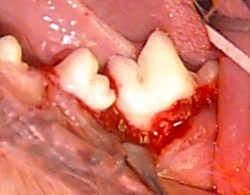 |
Home care recommendationsHomecare is just as important as regular dental cleanings to ensure your pet a healthy mouth for all of his or her life. We will make specific recommendations based on your pet’s circumstances. For more general information, see the section on dental homecare.
|
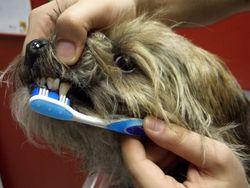 |
